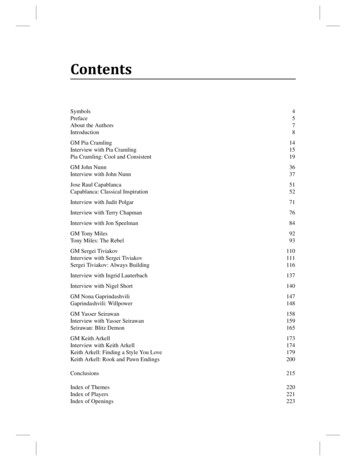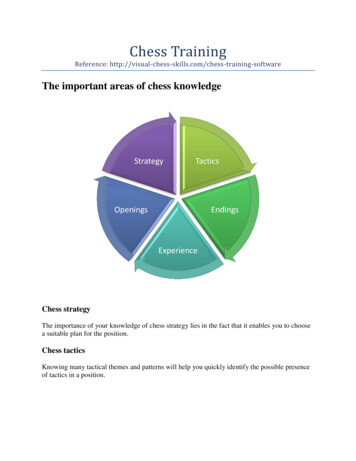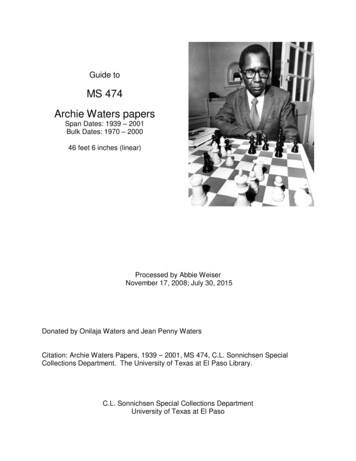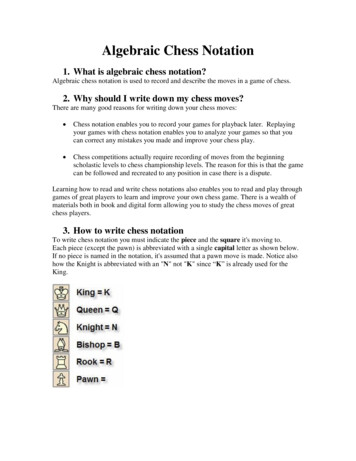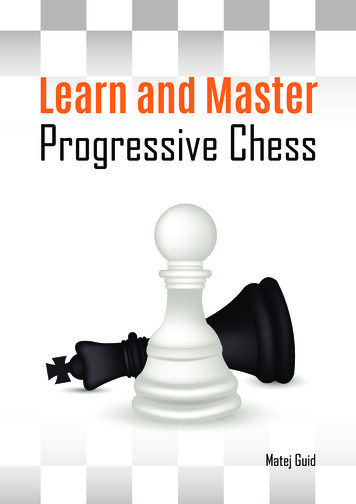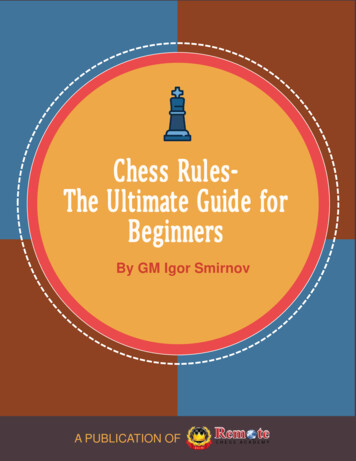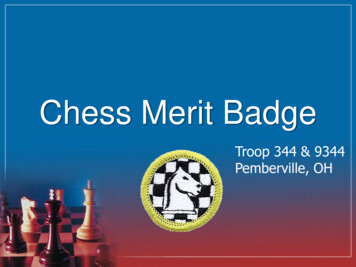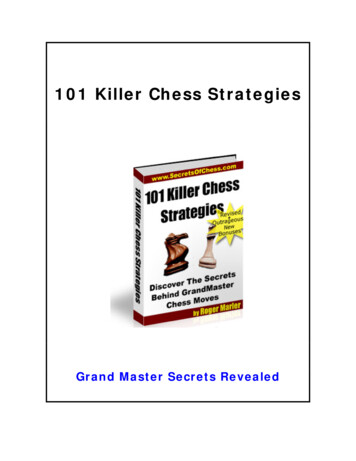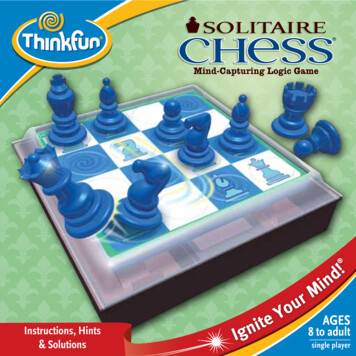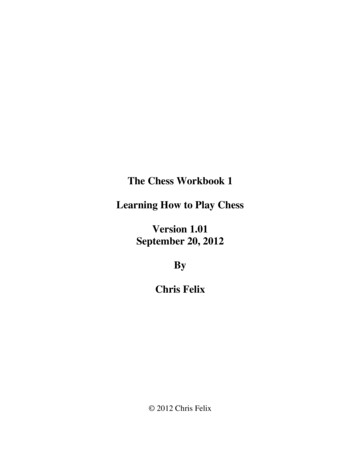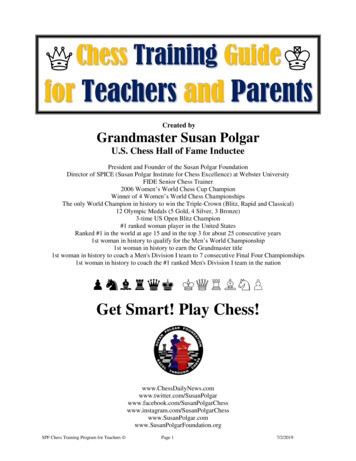
Transcription
Q Chess Training Guide Kfor Teachers and ParentsCreated byGrandmaster Susan PolgarU.S. Chess Hall of Fame InducteePresident and Founder of the Susan Polgar FoundationDirector of SPICE (Susan Polgar Institute for Chess Excellence) at Webster UniversityFIDE Senior Chess Trainer2006 Women’s World Chess Cup ChampionWinner of 4 Women’s World Chess ChampionshipsThe only World Champion in history to win the Triple-Crown (Blitz, Rapid and Classical)12 Olympic Medals (5 Gold, 4 Silver, 3 Bronze)3-time US Open Blitz Champion#1 ranked woman player in the United StatesRanked #1 in the world at age 15 and in the top 3 for about 25 consecutive years1st woman in history to qualify for the Men’s World Championship1st woman in history to earn the Grandmaster title1st woman in history to coach a Men's Division I team to 7 consecutive Final Four Championships1st woman in history to coach the #1 ranked Men's Division I team in the nationpnlrqk KQRLNPGet Smart! Play PolgarFoundation.orgSPF Chess Training Program for Teachers Page 17/2/2019
Lesson 1Lesson goals: Excite kids about the fun game of chessRelate the cool history of chessIncorporate chess with education: Learning about India and PersiaIncorporate chess with education: Learning about the chess board and its coordinatesWho invented chess and why?Talk about India / Persia – connects to GeographyTell the story of “seed”.There can be possible homework relating to India and Persia. Do online search or lesson in class. Whatare the countries called today (which used to be called Persia)? What is the population of India? Whichcountries border India? What is the official language of India? Etc.Introduce “The Chess Board”XABCDEFGHY8- - - - (7 - - - -'6- - - &5 - - - -%4- - - - 3 - - - -#2- - - "1 - - - -!xabcdefghyHow many squares (64)? How many White / Black squares (32 each)?What are Ranks (1-8), Files (a-h), Diagonals, Kingside, Queenside, etc.The horizontal lines going up (1-8) are called Ranks, and the vertical lines from left to right (a-h) arereferred to as Files. Diagonals are rows of squares of the same color slanting across the board. There aremany diagonals on the chessboard. The side with the letters a through d is called Queenside and e-hcalled Kingside.Practice Names of squares. Find a1, c4, g6 and so on.Stress how chess can be used in the children’s everyday life, such as reading a map. (Geography)SPF Chess Training Program for Teachers Page 27/2/2019
Lesson 2Lesson goals: Introduce the PawnHow the Pawn movesHow the Pawn capturesWhat is Pawn promotion?What is the scoring system in chess?The Pawn - Value 1 Point each.There are eight Pawns for each side.This is how we set them upon the 2nd and 7th rankXABCDEFGHY8- - - (7zppzppzppzpp'6- - - - &5 - - - -%4- - - - 3 - - - -#2PzPPzPPzPPzP"1 - - - !xabcdefghyHere are the rules about Pawn moves:Pawns move straight ahead one square at the time. However, in any chess game, each Pawn can moveforward (jump) two squares once from its initial position. If a Pawn is still in its starting position it canchoose to move one or two squares up. Once it has moved (one or two squares), that Pawn can onlyadvance one square up at the time.Pawns, unlike other chess pieces, capture differently than they move. The Pawn moves forward butcaptures diagonally.Pawns are the only pieces which do not move backwards!The Pawn is the only piece which can promote (become another piece). It can become any piece except aKing. Once a Pawn reaches the last rank, the Pawn cannot remain a Pawn. It must become another piecesuch as Queen, Rook, Bishop or Knight. The Pawn usually promotes to a Queen as it is the most valuablepiece in chess.Play the “Pawn War” (without Kings!) game. The goal is to get across to the other side of the board and promote. The one who promotes first wins!What is the scoring system in chess? Math1 point for win½ point for draw0 for lossSPF Chess Training Program for Teachers Page 37/2/2019
Lesson 3Lesson goals: How to use your Pawns more effectivelyThe “Break Through” in Pawn endgamesIntroduce a special “En passant” ruleRelate to France / French cultureThe importance of passed Pawns and how to create them!XABCDEFGHY8- - - - (7zp- p - -'6- -zP- &5 -zP- - -%4- - - - 3 - - - -#2- - - "1 - - - -!xabcdefghyIn the position above, White can sacrifice a Pawn to create a passed Pawn and promote it. Solution: 1.c6and after Black answers with 1 dxc6 2.d7 and the Pawn promotes on the next move.In the position belowXABCDEFGHY8- - - - (7 - pzp- -'6- p - &5 - -zP- -%4- -zP-zP- 3 - - - -#2- - - "1 - - - -!xabcdefghyWhite should continue with f4-f5, followed by f5-f6 creating a passed Pawn.Show the basic pawn breakthrough with symmetrical Pawns.SPF Chess Training Program for Teachers Page 47/2/2019
XABCDEFGHY8- - - - (7zppzp- - -'6- - - &5zPPzP- - -%4- - - - 3 - - - -#2- - - "1 - - - -!xabcdefghySolution: 1.b6! The only move which wins! If Black plays 1 axb6, then 2.c6! bxc6 3.a6 or 1 cxb62.a6! bxa6 3.c6. If it is Black to move the only correct defense is 1 b6! On the other hand, 1 c6 losesto 2.a6! or 1 a6 loses to 2.c6!The “En passant” rule: When any Pawn moves two spaces up from its initial position, it may need toworry about an unexpected danger. En passant is a French expression used in chess. It means “InPassing”.Let’s see an example:XABCDEFGHY8- - - - (7 - p - -'6- - - &5 -zP-zP- -%4- - - - 3 - - - -#2- - - "1 - - - -!xabcdefghyIn the position above after Black plays 1 d7-d5XABCDEFGHY8- - - - (7 - - - -'6- - - &5 -zPpzP- -%4- - - - 3 - - - -#2- - - "1 - - - -!xabcdefghySPF Chess Training Program for Teachers Page 57/2/2019
White can capture with either the e5 or c5 Pawn by moving it to d6 and removing Black’s Pawn on d5from the board, as shown in the diagram below.XABCDEFGHY8- - - - (7 - - - -'6- -zP- &5 -zP- - -%4- - - - 3 - - - -#2- - - "1 - - - -!xabcdefghyXABCDEFGHY8- - - - (7 - - - -'6- -zP- &5 - -zP- -%4- - - - 3 - - - -#2- - - "1 - - - -!xabcdefghyRemember “en passant” can only be done immediately after the opponent’s Pawn moved two squares upor this special right is lost.Practice more “Pawn wars” while using the en passant rule as well!The “French connection” lesson: Look for a couple of French related words, cities, food, etc.SPF Chess Training Program for Teachers Page 67/2/2019
Lesson 4Lesson goals: Introducing the RookThe value of the RookHow the Rook moves and capturesHow the Rook can/should fight against PawnsIntroduce the Rook. Each side has two Rooks. Their starting positions are a1 and h1 for White and a8 andh8 for Black.What does a Rook look like? A tower or castleValue 5 Points or equivalent to 5 PawnsThe Rook moves on “tracks like a train”. Always in straight lines, up, down, left, or right.See examples of how to capture 8 Pawns (with no other pieces on the board, only White moves) with theRook.XABCDEFGHY8- - - - (7zppzppzppzpp'6- - - &5 - - - -%4- - - - 3 - - - -#2- - - "1 - - - R!xabcdefghySolution: The Rook can capture all the Black Pawns, in the following order: h7, g7, f7, e7, d7, c7, b7 anda7. Here is another example:XABCDEFGHY8- - - - (7 - - p p'6p -zp- &5 - - - -%4- -zp-zp- 3 p - - p#2- - - "1tR- - - -!xabcdefghySPF Chess Training Program for Teachers Page 77/2/2019
Solution: The Rook can capture all the Black Pawns in the following order: a6, d6, d4, f4, f7, h7, h3 andb3.You can find many further examples in the “Chess Mazes” book.See examples, when Rook versus Pawns, both sides are making moves.XABCDEFGHY8- - - - (7 p - - -'6- - - &5 - - - -%4- - - - 3 - - - -#2- - - "1 - - - R!xabcdefghyWhich is the fastest way to capture the Black Pawn? 1.Rb1 then Rxb7In the next position, White has to play accurately to make sure neither Black Pawn will promote.XABCDEFGHY8- - - - (7 - - - -'6- - - &5 - - - -%4- -zp- - 3 - -zp- -#2- - - "1tR- - - -!xabcdefghyHere it would be wrong to attack the d4 Pawn with 1.Rd1 because after 1 e2 2.Re1 d3 one of the BlackPawns will promote. The correct answer is 1.Re1! and Black soon will lose both of the Pawns. Forexample: 1 d3 2.Rxe3 d2 3.Rd3.SPF Chess Training Program for Teachers Page 87/2/2019
Let the students play games from this position:XABCDEFGHY8- - - - (7 -zppzppzpp'6- - - - &5 - - - -%4- - - 3 - - - -#2- - - "1tR- - - -!xabcdefghyPlay up to 20 moves. If by then white hasn’t captured all of Black’s Pawns or Black hasn’t promoted anyof the Pawns call it a draw.RrSPF Chess Training Program for Teachers Page 97/2/2019
Lesson 5Lesson goals: How a Rook can best help (or fight against) a PawnIntroduce the BishopHow the Bishop moves and capturesCompare the values of the Pawn, Bishop and the RookHere is a basic Rook and Pawn versus Rook endgame principle: usually a Rook is better behind a Pawnwhether it is your own or your opponent’s Pawn. See examples:XABCDEFGHY8- - - -tr(7 - - - -'6- - - - &5 - - - -%4- - - zP 3 - - - -#2- - - "1 - R - -!xabcdefghyIn the position above, the White Rook should defend the Pawn on h4 from h1. (Defending from d4 makesno progress as Black would simply make waiting moves with the Rook along the h file) Then, after1 Rh5 (which tries to prevent to Pawn from advancing), White makes a “waiting move” 2.Rh2 or2.Rh3. After that the Black Rook must move away from h5, allowing White’s Pawn to advance. Forexample: 2 Rh8 3.h5 Rh6 4.Rh2 Rh8 5.h6 Rh7 6.Rh1 Rh8 7.h7.On the other hand if the Rook of the defensive side is behind the Pawn, the Pawn cannot reach thepromotion square successfully. Let’s reverse the color of the Rooks from our last example.XABCDEFGHY8- - - -tR(7 - - - -'6- - - - &5 - - - -%4- - - zP 3 - - - -#2- - - "1 - r - -!xabcdefghyHere Black can hold up White’s Pawn by playing 1 Rh1 and simply making moves along the h file. (Bythe way 1 Rd4 2.h5 Rd5 3.h6 Rd6 4.h7 Rd7 also works in this case.)Of course it is important to stress that these are basic training examples, no other pieces on the board.SPF Chess Training Program for Teachers Page 107/2/2019
Introduce the Bishop. Each side has two Bishops. Their starting positions are c1 and f1 for White and c8and f8 for Black.What does the Bishop look like? Show several Bishops from various sets. The slit symbolizes the twopointed hat that Catholic Bishops wear.Value 3 Points or equivalent to 3 PawnsThe Bishop moves only on diagonals consisting of the same color squares as the Bishop is on. It cannever move to a different color square than where it starts at the beginning of the game.Show examples of how to capture 8 Pawns (with no other pieces on the board, only White moves) withthe Bishop.XABCDEFGHY8- - - - (7 - - p -'6- p p - &5 - - - p%4p p - - 3 - - p #2p L - - "1 - - - !xabcdefghySolution: The Bishop can capture all of Black’s Pawns (assuming that only White moves), in thefollowing order: a4, c6, f3, h5, f7, e6, c4 and a2.You can use the “Chess Mazes” book for further examples.Play a few games 2 Bishops vs. 2 Rooks, each starting in their regular starting positions. If within 15moves neither side won any piece it’s a draw. Whoever captures a piece wins the game. If one side wins aBishop but on the next move the other side can capture a Rook, the side winning the Rook wins (as it is amore valuable piece).Do math exercises. What is worth more? 1 Rook or 2 Bishops? 7 Pawns or a Rook? etc.SPF Chess Training Program for Teachers Page 117/2/2019
Lesson 6Lesson goals: How can the Bishop be used effectively against PawnsIntroducing the QueenThe value of the QueenHow the Queen moves and capturesAll Pawns can be blocked if they are on the same diagonal see example.XABCDEFGHY8-vl- - - (7 P - - -'6- P - - &5 - P - -%4- - P - 3 - - P -#2- - "1 - - - -!xabcdefghyIn the above position, the Black Bishop effectively blocks the road of all the White Pawns.Again without Kings on the Board, play games of a Bishop versus 3 Pawns (from the position you seebelow) to get a better feel of the Bishop’s powers and limitations.XABCDEFGHY8- - - - (7 - - pzpp'6- - - - &5 - - - -%4- - - - 3 - - - #2- - -vL- "1 - - - !xabcdefghyIf one of the Pawns promotes, that’s a win, also if one side loses the Bishop that’s a loss. If all the Pawnsare lost, the side with the Bishop wins.After experimenting in the classroom show the correct method of play:White can hold up all three Pawns and eventually capture them. But only if White finds the correct planstarting with 1.Bc5!, followed by 2.Bf8. For example: 1 h5 2.Bf8 g5 3.Be7 g4 4.Bh4 f5 5.Bg3. NowBlack starts losing the Pawns 5 h4 6.Bxh4 f4 7.Bg5 f3 8.Bh4.SPF Chess Training Program for Teachers Page 127/2/2019
However, attacking the Pawn from d4 would not serve the same purpose: 1.Bd4 f6! 2.Bc5 h5 3.Bf8 h44.Bxg7 h3 5.Bxf6 and after 5 h2 the Pawn cannot be caught.Introduce the Queen. Each side has one Queen. Their starting positions are d1 for White and d8 forBlack.What does the Queen look like?Value 9 Points or equivalent to 9 Pawns / 2 Bishops and 3 Pawns / 2 Bishops and 1 Knight / 2 Knightsand 1 Bishop / 1 Bishop or 1 Knight and 6 Pawns, etc.The Queen moves on files, ranks and diagonals. It is like a combination of a Rook and Bishop.Show examples of how to capture 8 Pawns (with no other pieces on the board, only the side with theQueen moves) with the Queen.XABCDEFGHY8- - - - (7 -zp- - -'6- - pzp- &5zp- - - p%4- - - - 3 - -zp-zp #2-zp- - - "1 - Q - !xabcdefghyThe following is the correct order of captures: h5, a5, c7, g3, e3, e6, f6 and b2.QqSPF Chess Training Program for Teachers Page 137/2/2019
Lesson 7Lesson goals: How can the Queen can be used effectively against PawnsThe “8 Queens Puzzle” on an empty boardCompare the value of the Queen to other piecesIntroduce the KingHow does the King move and capturePractice more examples of Queen fighting against the Pawns. Play out Queen versus 8 Pawns in theirstarting position. The easier example would be White to move first. To make it a little more challenging,let Black moves first.XABCDEFGHY8- - - - (7zppzppzppzpp'6- - - - &5 - - - -%4- - - 3 - - - -#2- - - "1 - Q - -!xabcdefghyIn this position, White should win against the eight Pawns because none of the Black Pawns areadvanced.The more advanced the Pawns are (meaning the closer to the promotion square they are) the moredangerous they are.XABCDEFGHY8- - - - (7 - - -'6- Q - - &5 - - - -%4- - - 3 - - - -#2- p - p "1 - - - -!xabcdefghyIn this position, even though the Black Pawns are only one square away from promotion, they can bestopped by 1.Qc5!SPF Chess Training Program for Teachers Page 147/2/2019
XABCDEFGHY8Q - - - (7 - -'6- - - - &5 - - - -%4- - - - 3 p - -zp-#2p - - - "1 - - - -!xabcdefghyIn this position, Black has three far advanced Pawns. By giving one up on the Kingside with 1 g2, Blackwill have at least one of the three Pawns reach the promotion square.Play Queen versus 2 Bishops game (no other pieces on the board). Black would move first here. Play 15moves. If neither side captures any piece it’s a draw.XABCDEFGHY8- l -vl- (7 - - - -'6- - - - &5 - - - -%4- - - 3 - - - -#2- - - "1 - Q - -!xabcdefghyTry to place 8 Queens on an empty board in a way that none of them can connect to other. In other word,you must place 8 Queens in such a way that none of them is in the path of another - horizontally,vertically, or diagonally.Here is one of the many solutions: Queens on a8, b2, c4, d1, e7, f5, g3, h6.Here is a place on the web to exercise th/puzzles/games/queens/queens.htmlLast but not least, introduce the King.It is a slow piece and can only move one square at a time. However, it can move in any direction.Play games with only the two Kings on the board. Whoever reaches the other end of the board first(1st/8th rank) wins.SPF Chess Training Program for Teachers Page 157/2/2019
Lesson 8Lesson goals: Introduce “Castling”Introduce the Knight.How does the Knight move and captureThe “Knight Tour”The Knight’s value compared to the other piecesExplain the purpose of castling, when you can and cannot castle.What does the Knight look like?Value 3 Points or equivalent to 3 Pawns or 1 BishopIt’s also commonly referred to as horse or horsy. The Knight is the only piece which can jump overanother piece. The Knight always alternates jumping from light to dark squares and then again dark tolight and so on. It jumps in an L-shape.Show examples of how to capture 8 Pawns (with no other pieces on the board, only the side with theKnight moves) with the Knight.XABCDEFGHY8- - - - (7 -zp- - -'6- - p - &5 p - - p%4- - pzp 3zp- - -zp-#2- - - "1 N - - -!xabcdefghySolution: The Knight will capture all of Black’s Pawns (assuming that only White moves), in thefollowing order: a3, b5, c7, e6, f4, h5, g3 and e4.Show how a centralized Knight (in the middle of the board) has so many more choices of moves (8) thanone in the corner (2).SPF Chess Training Program for Teachers Page 167/2/2019
XABCDEFGHY8- - - - (7 - - - -'6- « « - &5 « - « -%4- -sN- 3 « - « -#2- « « "1 - - - -!xabcdefghyXABCDEFGHY8- - - - (7 - - - -'6- - - - &5 - - - -%4- - - 3 « - - -#2- « - "1sN- - - -!xabcdefghyTry to jump with the Knight from one square to another covering all 64 squares on the chess board,landing only once on each square. Here is one of the countless solutions to the “Knight tour”. The Knightstarts at square #1 and ends at #64. Here is a wonderful link to practice it:http://www.mindmagician.org/tour3.aspxIf you are really interested to learn more about this fascinating subject read this:https://en.wikipedia.org/wiki/Knight%27s tourSPF Chess Training Program for Teachers Page 177/2/2019
Lesson 9Lesson goals: Summarize the value of all the piecesWhat is one of the goals in chess: Checkmate!What is the difference between check and checkmatePawn 1Knight 3Bishop 3Rook 5Queen 9Summarize of the value of all the pieces.Practice capturing. Play “Market”. Capture the more valuable piece.Goal of a chess game: Checkmate! Explain the difference between check and checkmate.Show a sample checkmate with each piece.Let’s start with the Queen.XABCDEFGHY8- - -mk- (7 -wQ- - -'6- - -mK- &5 - - - -%4- - - - 3 - - - -#2- - - - "1 - - - -!xabcdefghyIn the position above White can checkmate in four different ways. 1.Qb8, 1.Qc8, 1.Qd8 or 1.Qf7. Alsopoint out where White can check: 1.Qd6, 1.Qc5, 1.Qe7 and 1.Qg7.Explain after each check where would the Black King escape.SPF Chess Training Program for Teachers Page 187/2/2019
Now let’s see how the Rook and the Bishop checkmate:XABCDEFGHY8- - - - (7 - - - -'6- - - - &5 - - -tR-%4- - - - 3 - - K k#2- - - - "1 - - - -!xabcdefghyXABCDEFGHY8- - - - (7 - - - -'6- -vL- - &5 - - - -%4- - - - 3 - L - -#2- - -mK- "1 - - - k!xabcdefghyThe Rook checkmates on h5 and the Bishop on e4.And finally let’s see a Knight and a Pawn checkmate.XABCDEFGHY8- - - rmk(7 - - -zpp'6- - - - &5 - -sN- -%4- - - -mK 3 - - - -#2- - - - "1 - - - -!xabcdefghyXABCDEFGHY8- - - lmk(7 - - - p'6- - - PmK&5 - - - -%4- - - - 3 - - - -#2- - - - "1 - - - -!xabcdefghyThe Knight checkmates on f7 (which is called as smothered mate) and the Pawn checkmates on g7.The number one requirement to give checkmate is to attack the opponent’s King with one of our pieces. Itcan be any piece except our own King. A King can never ever directly attack the enemy King. The secondrequirement is – and this is the one which differentiates a check from a checkmate – to make sure theKing has no escape.KkLet’s see now some situations when it is almost checkmate but not quite.In the next position, Black is in check but not checkmate.SPF Chess Training Program for Teachers Page 197/2/2019
XABCDEFGHY8- - - -mk(7 - - - -'6- - - -wQ&5 - - K -%4- - - - 3 - - - -#2- - - - "1 - - - -!xabcdefghyThe Black King can move out of the check to g8.XABCDEFGHY8- - - -mk(7wq- - -wQ-'6- - -mK- &5 - - - -%4- - - - 3 - - - -#2- - - - "1 - - - -!xabcdefghyIs Black checkmated in the above position? No, because the Black Queen can take the White Queen.And here is an example when the check will be blocked by another piece interposing.XABCDEFGHY8- - - -mk(7 - - K -'6- - - - &5 - - - -%4- - - -tR 3 - - - -#2- - - - "1 l - - -!xabcdefghyThe Black King is in check and cannot escape. The White Rook cannot be captured either. Is it acheckmate? No, because the Black Bishop can block the check on h7.So, it is checkmate when the enemy King is under a direct attack and: 1. The King has no safe square tomove to 2. It is not possible to block the check 3. It is not possible to capture the piece that is checking theKing.SPF Chess Training Program for Teachers Page 207/2/2019
Lesson 10Lesson goals: How to checkmate in one moveWhat is stalemate?Differentiate check, checkmate and stalematePractice checkmates in one move.XABCDEFGHY8q - - k (7 - - p p'6- -zpp pzP&5 - - - -%4- - - - 3 -wQP - -#2- - -zP- "1 - - -mK-!xabcdefghyXABCDEFGHY8- - - rmk(7 - - pzp-'6- - - - &5 - - - -%4R - - - 3 - -zP- -#2- - -mK- "1 - - - -!xabcdefghy(1.Qg7)(1.Rh4)XABCDEFGHY8- - - k (7 - - p p'6- -zpp pzP&5 - -wq- -%4- - - - 3 -wQP - -#2- - -zP- "1 - - -mK-!xabcdefghyXABCDEFGHY8-mk- r - (7 -zp- - -'6-zp- - - &5 - - - -%4Q - - - 3tR- - - -#2- P q - "1 K - - -!xabcdefghy(1.Qc8)(1.Qa8)Introduce Stalemate.A stalemate happens when it is a player’s move, his or her King is not in check, yet no legal move can bemade. When stalemate occurs, the game results in a draw, meaning each player gets half a point. That canbe very disappointing for the side which has a big advantage. Make sure you do your best to avoidstalemate when you are in a winning position.SPF Chess Training Program for Teachers Page 217/2/2019
Here are some examples.In the four positions below, it is Black’s turn. They are stalemate positions.XABCDEFGHY8- - - k (7 - - - -'6- - -mK-wQ&5 - - - -%4- - - - 3 - - - -#2- - - - "1 - - - -!xabcdefghyXABCDEFGHY8- - -mk- (7 - - P -'6- - -mK- &5 - - - -%4- - - - 3 - - - -#2- - - - "1 - - - -!xabcdefghyXABCDEFGHY8- - - - (7 - - K -'6- - - -mk&5 R - - -%4p - - - 3zP- L - -#2- - - - "1 - - - -!xabcdefghyXABCDEFGHY8k - - - (7 - - - -'6PmKN - - &5 - - - -%4- - - - 3 - - - -#2- - - - "1 - - - -!xabcdefghyBut the following positions are not stalemate, even though the Black King has no legal moves because thePawn can move.XABCDEFGHY8k - - - (7 - - - -'6PmKN - - &5 - - - p%4- - - - 3 - - - -#2- - - - "1 - - - -!xabcdefghySPF Chess Training Program for Teachers XABCDEFGHY8- - - - (7 - - K -'6- - - -mk&5 R - - -%4p - - - 3 - L - -#2- - - - "1 - - - -!xabcdefghyPage 227/2/2019
Lesson 11Lesson goals: How to checkmate with King and Queen versus a lone KingDo test on differentiating between check, checkmate and stalemate.Test for Lesson 11XABCDEFGHY8- - -mk- (7 - - - -'6- - K - &5 - - - Q%4- - - - 3 - - - -#2- - - - "1 - - - -!xabcdefghyWhite to move. Show two ways White can checkmate. Show four ways that give check. Which one of thechecks would be a big mistake? Show a move that would end the game in stalemate instantly andtherefore should be avoided.Learn to checkmate with K Q versus K with no other pieces on the board.There is one very important fact that we need to know about endgames with only K Q versus K on theboard: The King can only be checkmated at the edge of the board, namely ether on the a or h file or beingon the 1st or 8th rank. Naturally if there is even one single other piece on the board for either side this isnot the case.Here is the game plan:1) Force the King to the edge of the board2) Cut it off and making sure it stays there3) Bring the King to help4) Checkmate!SPF Chess Training Program for Teachers Page 237/2/2019
Now let's see it in practice:XABCDEFGHY8- - - -wQ(7 - - - -'6- - - - &5 - k - -%4- - - - 3 - - - -#2- - - - "1mK- - - -!xabcdefghyThe Black King is right in the middle of the board on d5. Knowing the above mentioned "fact" we have toput as a priority forcing the Black King to the "wall".1.Qf6 With this move, White has put the Black King in a "box". Meaning the Black King cannot cross thef file or the 6th rank. 1 Ke4 The Black King still can stay in the middle of the board.2.Qg5 Kd4 3.Qf5 Ke3 4.Qg4 With each move, White is tightening the belt, making the box smaller andsmaller.Kd3 5.Qf4 Kc3 6.Qe4 Kd2 7.Qf3 Kc2 8.Qe3 Kd1 We have achieved goal Part 1 of the plan, theBlack King has been forced to the edge of the board. With the next move White makes sure it stays there.9.Qf2 Kc1 And now, it is time for Part 3, bringing the King to help. 10.Ka2 Kd1 11.Kb3 Kc1 12.Qc2checkmate.SPF Chess Training Program for Teachers Page 247/2/2019
Lesson 12Lesson goals: How to set up all the chess pieces on the boardCenterDevelopmentKing safetyBasic Opening PrinciplesRepeat K Q versus K checkmate method learned in Lesson 11. Let the students play a King and Queenversus King position. The side with the Queen has 20 moves to checkmate. If there is no checkmatewithin 20 moves, the other side wins.(Note, this only a special rule for this exercise, not in a real game. In a real game one has up to 50 movesto checkmate. However from any given position K Q vs. K checkmate can be reached in no more than 17moves.)How to set up all the pieces. Rooks are in the corner, next to the Rooks the Knights, next to them theBishops. In the middle are the King and the Queen. The Queen is always on its on color.XABCDEFGHY8rsnlwqkvlntr(7zppzppzppzpp'6- - - - &5 - - - -%4- - - - 3 - - - -#2PzPPzPPzPPzP"1tRNvLQmKLsNR!xabcdefghyWhite starts the chess game.Teach the children to put the pieces neatly in the middle of the square and not in between two or moredifferent squares.The center (e4, d4, e5, d5 squares)Castling rules. What is its purpose? The put the King in safety. Usually we recommend castling within thefirst 6-8 moves of the game to avoid the King getting in trouble.Basic opening principles1.2.3.4.5.Control the Center!Develop your pieces as soon as possible!Castle as soon as possible!Do not bring out your Queen early!Do not move the same piece twice, before you have completed development! (unless it isbeing attacked or you can capture something for free).SPF Chess Training Program for Teachers Page 257/2/2019
Chess notationIf a Queen moves from d1 to h5, we would write Qd1-h5 or simply Qh5. The symbol for capturing apiece is x. Therefore, if you capture a piece you would write Qxh5. If you give a check you add a “ ”after the move.For a Rook move, you write R; For a Bishop move B; King move K; Knight move N (not to mix it upwith a King move). If a Pawn moves you do not need to write P, just the name of the square the Pawn ismoving to. Castling has a special notation. Castling to the King (short) side you write 0-0 and 0-0-0 forcastling to the Queenside.How to record a chess game and why? Here are two important reasons: To be able to go back and learnfrom your mistakes or to show off a beautiful combination. Also to be able to prove what the position ison the board in case your opponent tries to cheat.Show miniature games. One side follows the basic opening principles while the other breaks the rules.Here is a sample which demonstrates a good start for White and a bad start for Black:1.e4 h5 2.d4 Rh7 3.Nf3 Na6 4.Nc3 Rb8 5.Bc4 Rh8 6.0–0 Nh6 7.Bf4XABCDEFGHY8-trlwqkvl-tr(7zppzppzppzp-'6n - - -sn&5 - - - p%4- LzPPvL- 3 -sN- N -#2PzPP -zPPzP"1tR- Q RmK-!xabcdefghyIn this example, White has been nicely following the basic opening principles, while Black hascompletely neglected them. Let the class play games focusing on following the basic opening principlesand on captures.Order of importance in chess: checkmate, winning pieces, gaining small strategical advantages.SPF Chess Training Program for Teachers Page 267/2/2019
Lesson 13Lesson goals: How checkmate with two Rooks versus a lone KingHow checkmate with one Rook versus a sole KingLearn K 2R versus K checkmate method.XABCDEFGHY8- - - - (7 - - - -'6- - - - &5 - - -mk-%4- - - - 3 - - - -#2- - -tR- "1mK- -tR- -!xabcdefghyThe method we checkmate a sole King with two Rooks is: using one Rook to limit the King’s mobility(like in the above example, the Rook on f2, stops the Black King from crossing through the f file) andother Rook to check the King forcing it towards the edge of the board. Let’s see how this actually works:1.Rg1 Kh4 2.Rh2 checkmate. You do not really need the help of the (White) King to checkmate a soleKing with two Rooks.How to checkmate with a Rook a sole King. Here, we will need the help of our King as one Rook cannotdo it on its own.XABCDEFGHY8- - - - (7 - - - -'6- - - - &5 - -mk- -%4- - - - 3 - - - -#2- - - - "1tR- -mK- -!xabcdefghyThe first step: Limiting the mobility of the Black King. 1.Ra4 Kd5 Next White brings the King to help.2.Kd2 Ke5 3.Kd3 Kd5 4.Ra5 Ke6 5.Kd4 Kf6 Now that the King is close by, ready to help, the WhiteRook starts limiting more and more the Black King’s moves. 6.Re5 Kf7 7.Kd5 Kf6 8.Kd6 Kf7 9.Re6Kg7 10.Ke7 Kg8 11.Rg6 Kh8 12.Kf7 Kh7 And now an important waiting move 13.Rf6 (Any Rookmove towards the Queen side would work, like 13.Ra6, 13.Rb6 and so on with the same purpose) Kh814.Rh6 checkmate.SPF Chess Training Program for Teachers Page 277/2/2019
Lesson 14Lesson goals: Introduce “Fork”Pawn forksKnight forks“Family fork”What is a fork? It is a tactical tool to gain material advantage or to checkmate. It is also called doubleattack. It means you attack two targets at once. Usually we would refer to attacking two of the opponentpieces at the same time. When one of the attacked pieces moves away we capture the other. In some othercases, we threaten with checkmate and attack an enemy piece.Each piece can fork. Let’s start with Pawn forks.XABCDEFGHY8- - - - (7 - p - -'6- - p - &5 -tr-mk- -%4- - - - 3 - -zP- -#2- -zPK - "1tR- - - -!xabcdefghyIn the above diagram positi
Chess Training GuideK for Teachers and Parents Created by Grandmaster Susan Polgar U.S. Chess Hall of Fame Inductee President and Founder of the Susan Polgar Foundation Director of SPICE (Susan Polgar Institute for Chess Excellence) at Webster University FIDE Senior Chess Trainer 2006 Women's World Chess Cup Champion
